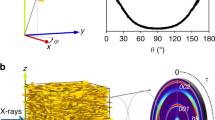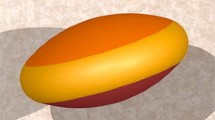Abstract
The oriented aggregates of flake-like clay minerals, prepared in the laboratory for X-ray identification purposes, are axially symmetric fabrics, with the axis of symmetry or pole perpendicular the surface. The density of the vectors normal to the basal planes of the clay particles has its maximum at the pole. A given number of particles is considered, and the degree of orientation is assumed variable with one single parameter t, defined as maximum density over constant average density ¯D. The decline of the basal vector density from the pole to the equator may then be described by a power of the cosine of the polar angle ϕ:
This formula yields a quantitative description of orientation patterns measured on artificial fabrics by means of X-ray diffraction and on the universal stage.
In some cases, the description may be refined by using a function composed of two additive cosine powers. The cosine power is by no means a mathematically unique solution but other possible functions are less versatile and yield no better fit with the experimental data. The Gauss distribution may be regarded as an approximation of (9) for very high degrees of orientation.
Zusammenfassung
Texturpräparate blättchenförmiger Tonminerale, wie sie zur Verstärkung der Basisreflexe bei der röntgenographischen Bestimmung hergestellt werden, sind rotationssymmetrische Gefüge. Die Symmetrieachse oder Pol steht senkrecht auf der Oberfläche und fällt mit dem Dichtemaximum der Basislote zusammen. Betrachtet man eine feste Anzahl Blättchen, so kann man fordern, daß die Güte der Orientierung nur von einem einzigen Parameter t abhängt, der als Verhältnis der variablen maximalen zur konstanten durchschnittlichen Lotdichte ¯D definiert wird. Der Dichteabfall vom Pol zum Äquator kann dann durch eine Potenz des Cosinus der Polardistanz ϕ beschrieben werden:
Diese Formel und ihre Varianten (9a-g) ermöglichen die quantitative Auswertung gemessener Röntgenund U-Tisch-Gefügedaten.
Die Übereinstimmung zwischen gemessener und berechneter Lotdichte kann in einigen Fällen durch Verwendung einer Summe aus zwei Cosinuspotenzen verbessert werden. Die Cosinuspotenz ist keineswegs die einzige Lösung des Problems. Andere mögliche Lösungen sind jedoch zunächst weniger handlich und liefern keine bessere Beschreibung der Meβwerte. Die Gauβ-Verteilung ist eine spezielle Näherung für (9) bei sehr großer Orientierungsgüte.
Similar content being viewed by others
References
Braitsch, O.: Quantitative Auswertung einfacher Gefügediagramme. Heidelberger Beitr. Mineral. Petrog. 5, 210–226 (1956).
Brindley, G. W., and S. S. Kurtossy: Quantitative determination of kaolinite by X-ray diffraction. Am. Mineralogist 46, 1205–1215 (1961).
Dunn, C. G.: The analysis of quantitative pole-figure data. J. Appl. Phys. 25, 233–236 (1954).
Engelhardt, W. v., and K. H. Gaida: Concentration changes of pore solutions during the compaction of clay sediments. J. Sediment. Petrol. 33, 919–930 (1963).
Fisher, R. A.: Dispersion on a sphere. Proc. Roy. Soc. (London), Ser. A 217, 295–305 (1953).
Green II, H. W.: Quartz: extreme preferred orientation produced by annealing. Science 157, 1444–1447 (1967).
Jasmund, K.: Texturaufnahmen von blättchenförmigen Mineralen submikroskopischer Größenordnung in einer Debye-Scherrer-Kamera. Neues Jahrb. Mineral., Monatsh. 3, 63–72 (1950).
Jetter, L. K., C. J. McHargue, and R.O. Williams: Method of representing preferred orientation. J. Appl. Phys. 27, 368–374 (1956).
Klug, H. P., and L. E. Alexander: X-ray diffraction procedures, p. 376–378. New York: Wiley 1954.
Lippmann, F.: Enhancement of (0k0) reflections of clay minerals in a Guinier camera. Contr. Mineral. and Petrol. 19, 260–270 (1968).
Niskanen, E.: Reduction of orientation effects in the quantitative X-ray diffraction analysis of kaolin minerals. Am. Mineralogist 49, 705–714 (1964).
Sander, B.: Einführung in die Gefügekunde geologischer Körper, Bd. II, S. 356–383. Wien: Springer 1950.
Schulz, L. G.: A direct method of determining preferred orientation of a flat reflection sample using a Geiger counter X-ray spectrometer. J. Appl. Phys. 20, 1030–1033 (1949).
Smart, P.: Particle arrangement in kaolin. Clays and Clay Minerals, Proc. 15th National Conf. 15, 241–254 (1967).
Taylor, R. M., and K. Norrish: The measurement of orientation distribution and its application to quantitative X-ray diffraction analysis. Clay Minerals 6, 127–142 (1966).
Thiem, H. J.: Quantitative Texturanalyse durch Röntgenintensitätsmessungen und ihre Anwendung auf experimentell verdichtete Kaolinitund Montmorillonit-Tone. Diss., Tübingen 1967.
Tressler, R. E., and W. O. Williamson: Particle arrangement and differential imbibition swelling in deformed or deposited kaolinite-illite clay. Clays and Clay Minerals, Proc. 13th National Conf. 13, 399–410 (1966).
Author information
Authors and Affiliations
Additional information
Herrn Prof. Dr. Wolf v. Engelhardt zum 60. Geburtstag gewidmet.
Rights and permissions
About this article
Cite this article
Lippmann, F. Functions describing preferred orientation in flat aggregates of flake-like clay minerals and in other axially symmetric fabrics. Contr. Mineral. and Petrol. 25, 77–94 (1970). https://doi.org/10.1007/BF00389778
Received:
Issue Date:
DOI: https://doi.org/10.1007/BF00389778




